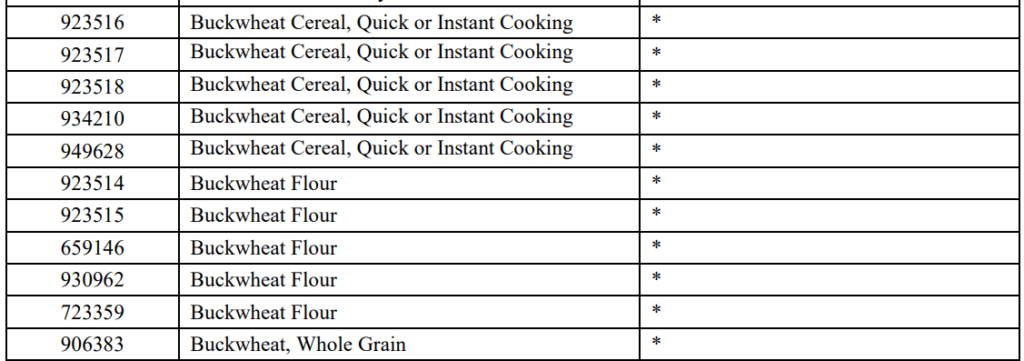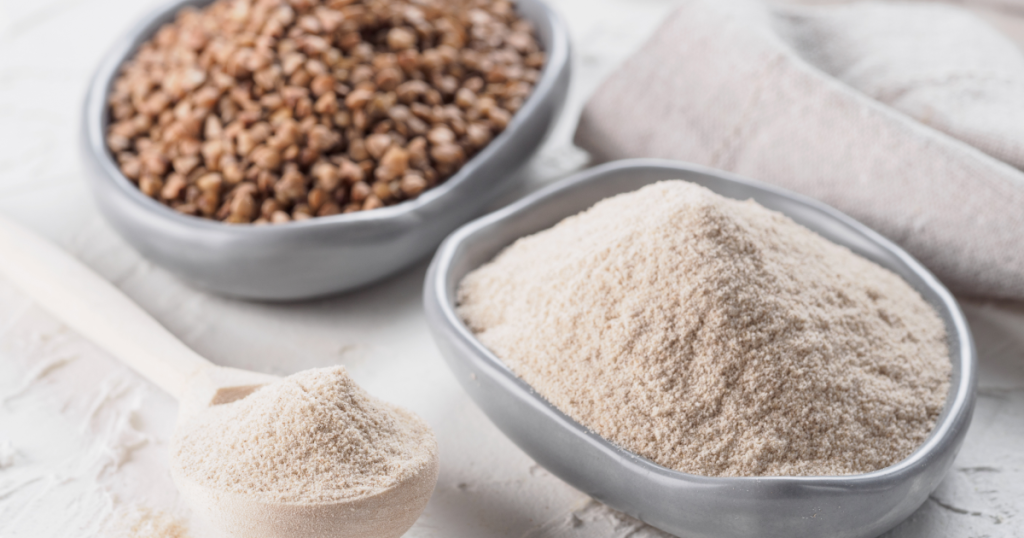
Is Buckwheat Gluten-Free? Bonus, buckwheat sandwich recipe.
Why Buckwheat Is Your New Best Friend and Is Buckwheat Gluten-Free?
In 2024 Regulatory agencies such as the U.S. Food and Drugs Administration have classified buckwheat as gluten-free, as has the Celiac Disease Foundation, which states that eating buckwheat is safe for people with gluten-related diseases. According to FDA test results from the FY 2015/16 buckwheat was recognized as gluten-free cereal (see on the picture):

FDA Test Results from the FY 2015/16
From a culinary perspective, buckwheat has a lot to offer: it is a versatile grain that has many uses and can add significant value to any dish. The question is: does buckwheat contain gluten? For people with gluten-related diseases, this is a problem that can have serious consequences. Let’s get to the bottom of the question and find out.
Is Buckwheat gluten-free basics
Buckwheat (not to be confused with wheat!) is actually not, strictly speaking, a cereal. It’s a subspecies of cereal called pseudocereal that has more in common with rhubarb than with wheat. That, however, doesn’t mean it’s worth any less than a “real” cereal: for centuries buckwheat was used in cuisines across the world with inevitable success.
Buckwheat also happens to be very popular among billions of people in Eastern Europe and Asia where it’s used for a variety of nutritious, energetic, and healthy dishes like noodles, pancakes, porridge, and more. It’s known to contain elements that will make your blood vessels stronger and more flexible, as well as lots of iron.

This is how buckwheat looks like on the field.
Dangers of gluten-based diseases
The World Health Organization has estimated that as many as 70 million people worldwide are suffering from various forms of gluten intolerance.
Besides celiac disease and wheat allergies, which are dangerous enough on their own, gluten is capable of triggering other troubling diseases. Among them are dermatitis herpetiformis, which causes painful, blistering rashes, and gluten ataxia, which causes neurological damage. Gluten-free diets also turned up better health results, including reduced risk of such as type 2 diabetes and heart disease.
In short, avoiding gluten seems to bring nothing but pros, and zero cons! The world is picking up on that, too, with consumption of gluten-free products rapidly going up, from 23.9% in 2012 to 35.5% in 2018, says Statistics Canada.
Gluten content
Rejoice! If you have concerns about ingesting gluten because you have a gluten-based illness, you’re completely safe with buckwheat. Cereals like barley, rye, which are actually different species, contain certain types of proteins that can cause reactions in gluten-sensitive people. Not being one of them, buckwheat is a healthy, safe, and tasty option. How exactly?
Protein composition of buckwheat
Buckwheat completely lacks two proteins (gliadin and glutenin) that make up gluten in other grains such as rye and barley. Buckwheat is mostly albumin and globulin, and there is no gluten in it.
Versatile and Nutritious:
In addition to being completely free of gluten, buckwheat is packed with powerful nutrients! It’s not only full of complex carbohydrates, but also supplies nine aminoacids, which are essential for healthy body functions for all types of diets, including vegans, vegetarians, and others.
Buckwheat is traditionally known to us as porridge or a cereal, but it can also be used in a variety of other dishes like salads and pancakes.

sample of buckwheat salad
Nutritional benefits
- Complex carbohydrates are just one substantial benefit of eating buckwheat, and already there are advantages there: because these are long-release, buckwheat means sustained energy through the day, as well as help in regulating body sugar levels. Celiac disease often means problems absorbing, which is why this is extremely helpful.
- There are nine essential amino acids in buckwheat that cannot be naturally synthesized by the body. Getting enough protein can be an issue for those with celiac disease, and amino acids can be very valuable in the process of breaking down proteins and integrating them into the system. besides repairing and growing muscle, there are a plethora of benefits for the body these aminoacids provide. Iron buckwheat happens to be rich in is also an active player.
- Buckwheat contains a variety of nutrients, including protein, fiber, iron, magnesium, phosphorus and manganese. It is also a source of antioxidants such as rutin and quercetin.
- Buckwheat is rich in protein and fiber, which can help increase feelings of fullness and reduce the number of calories you consume.
- Buckwheat may help lower blood cholesterol levels, which may reduce your risk of developing heart disease.
- The fiber found in buckwheat can help improve digestion and support gut health.
Is there definitely no gluten in buckwheat?
Gluten is a protein found in grains such as wheat, barley and rye. Buckwheat is a grass seed that is not a grain, so it does not contain gluten. This makes buckwheat an excellent choice for people with celiac disease or gluten intolerance. In addition, buckwheat is rich in protein, fiber, vitamins and minerals, which makes it useful for everyone who follows a healthy lifestyle.
Versatile and nutritious
These are just some of the useful ingredients you’ll find in buckwheat:
Protein
Buckwheat contains about 12 g of protein per 100 g of product, making it an excellent source of plant-based protein.
Carbohydrates
Buckwheat contains about 70 g of carbohydrates per 100 g of product, including slow-digesting carbohydrates that provide a long-lasting feeling of fullness.
Fiber
Buckwheat contains about 10 g of fiber per 100 g of product, which helps improve digestion and lower blood cholesterol.
Minerals
Buckwheat is rich in minerals such as iron, magnesium, phosphorus, potassium and zinc.
Vitamins
Buckwheat contains B vitamins, vitamin E and a small amount of vitamin C.
Antioxidants
Buckwheat contains antioxidants such as rutin and quercetin, which help protect cells from free radical damage.
Phytonutrients
Buckwheat contains phytonutrients such as linoleic acid and fagopyrosidine, which may help reduce the risk of heart disease and diabetes.
These are just some of the beneficial substances that can be found in buckwheat. Including buckwheat in your diet can help improve your health and well-being.

Selected buckwheat groat
Incorporating Buckwheat Flour
You can use buckwheat in a variety of recepies. While you’re truly only limited by your imagination, here’s a list to get you started:
Buckwheat porridge is perhaps the most popular way to use buckwheat in cooking. It can be prepared with water or milk, adding butter, salt and other ingredients to taste.
Buckwheat pancakes are a very tasty and nutritious dish that can be prepared from buckwheat flour, eggs, milk and other ingredients. Buckwheat pancakes can be served with honey, sour cream or other sauces.
Buckwheat cutlets are suitable for both meat eaters and vegetarians. To prepare cutlets, you need to mix buckwheat with egg, onion, garlic and other ingredients, form cutlets and fry them in a frying pan.
Buckwheat soup is a very nutritious and tasty dish that can be prepared from buckwheat, meat, vegetables and other ingredients. The soup can be served with bread or croutons.
Buckwheat goes well with vegetables, herbs, meat and other products. You can prepare a variety of salads from it, which will be not only tasty, but also healthy.
Best Buckwheat Recipe: Buckwheat Sandwich Bread with Mozzarella, Italian Salami, and Green Olives
If you’re searching for a delicious gluten-free sandwich option, try the recipe for Buckwheat Sandwich Bread with Mozzarella, Italian Salami, and Green Olives. Buckwheat flour provides a nutty flavor and a wonderful texture while keeping it gluten-free.
Here are the ingredients:
For the Buckwheat Sandwich Bread:
1 1/2 cups of gluten-free buckwheat flour
1/2 cup of gluten-free brown rice flour
1 1/2 teaspoons of baking powder
1/2 teaspoon of baking soda
1 teaspoon of salt
2 large eggs
1 1/2 cups of plain Greek yogurt
1/4 cup of olive oil
For the Sandwich Filling:
Mozzarella cheese slices
Italian salami slices
Sliced green olives
Fresh basil leaves (optional)
Your favorite gluten-free condiments (e.g., mustard, mayonnaise)
To make the bread, combine gluten-free buckwheat flour, gluten-free brown rice flour, baking powder, baking soda, and salt in a large bowl. In a separate bowl, whisk the eggs, Greek yogurt, and olive oil until smooth.
Pour the ingredients into the dry ingredients and stir until well combined, creating a thick and slightly sticky dough. Transfer the dough into a preheated loaf pan lined with parchment paper, smoothing the top with a wet spatula or spoon.
Bake the bread in the preheated oven for 45-50 minutes or until a toothpick inserted into the center comes out clean and the bread is golden brown. Let the bread cool in the pan for a few minutes, then transfer it to a wire rack to cool completely. Once the bread is cool, slice it into sandwich-sized pieces.
To assemble your sandwich, take a slice of buckwheat bread and layer with mozzarella cheese, Italian salami, green olives, and fresh basil leaves if desired.
Add your preferred gluten-free condiments, and top with another slice of buckwheat bread. Serve your gluten-free buckwheat sandwich with a side salad, chips, or your favorite gluten-free side dish.
Enjoy your homemade gluten-free Buckwheat Sandwich Bread with Mozzarella, Italian Salami, and Green Olives – a delicious and satisfying meal that everyone can enjoy, whether they’re gluten-free or not.
Read more articles






